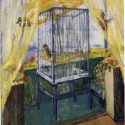Hulda Dagny Lütken was the daughter of a school master, was born and grew up in Elling in Vendsyssel, attended her father’s school, learned home economics, and married in 1917. When she divorced in 1923, she had to give up her daughter and subsequently became a housekeeper in Copenhagen until 1934, when it became possible for her to make a living from her writing. In the 1920s, she frequented the artistic and literary circle known as Valbyparnasset; in the 1930s, she was a central and much-admired figure among those associated with the periodical Vild Hvede. As an artist, she was temperamental and eccentric, and she identified with her mother’s Romany roots.
Her debut work, the poetry collection Lys og Skygge, was published in 1927, and she wrote nine poetry collections and five novels about the tension between desire and moral purity, eros and death, such as Lokesæd I-II (P), 1931, which uses a mythical universe, and also wrote her larger autobiographical confessional book Mennesket på Lerfødder. Bogen om en sjæl, 1943.
Her poetry, which is traditional and rhyming, begins to become experimental with Drømmen, 1940, and continues in this vein. Hulda Lütken tried to liberate herself from the late-Romantic imagery that was the source of her writing and to express a new, potent experience of her own self. In her last works, she conducts a dialogue with her own writing and the artist’s role and place in society.


